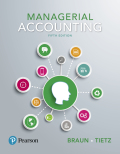
Concept explainers
Operating expenses budget and an income statement (Learning Objective 2)
Evansville Preschool operates a not-for-profit morning preschool that operates eight months of the year. The preschool has 190 kids enrolled in its various programs. The preschool’s primary expense is payroll. Teachers are paid a flat salary each of the eight months as follows:
| Teachers of two-day program | $ 428 per month |
| Teachers of three-day program | $ 657 per month |
| Teachers of four-day program | $ 856 per month |
| Teachers of five-day program | $1,075 per month |
| Preschool director’s salary | $1,500 per month |
Evansville Preschool has 9 two-day program teachers, 4 three-day program teachers, 5 four-day program teachers, and 4 five-day program teachers. The preschool also has a director.
In addition to the salary expense, the preschool must pay federal payroll taxes (FICA taxes) in the amount of 7.65% of salary expense. The preschool leases its facilities from a local church, paying $4,050 every month it operates. Fixed operating expenses (telephone, Internet access, bookkeeping services, and so forth) amount to $890 per month over the nine-month school year. Variable monthly expenses (over the eight-month school year) for art supplies and other miscellaneous supplies are $13 per child. Revenue for the entire nine-month school year from tuition, registration fees, and the lunch program is projected to be $241,300.
Requirements
- 1. Prepare Evansville Preschool’s monthly operating expenses budget. Round all amounts to the nearest dollar.
- 2. Using your answer from Requirement 1, create Start Evansville Preschool’s
budgeted income statement for the entire eight-month school year. You may group all operating expenses together. - 3. Start Evansville is a not-for-profit preschool. What might the preschool do with its projected income for the year?
Want to see the full answer?
Check out a sample textbook solution
Chapter 9 Solutions
Managerial Accounting (5th Edition)
- Can you solve this general accounting question with the appropriate accounting analysis techniques?arrow_forwardI am searching for the accurate solution to this general accounting problem with the right approach.arrow_forwardNeed Help About this Financial Accounting Question With Correct Answer..arrow_forward
- Please provide the correct answer to this general accounting problem using valid calculations.arrow_forwardI need help solving this general accounting question with the proper methodology.arrow_forwardNo AI The accounting principle that requires matching revenues with related expenses is the:A. Going Concern PrincipleB. Matching PrincipleC. Cost PrincipleD. Full Disclosure Principlearrow_forward
- Revenue is recognized in the accounting records when it is:A. CollectedB. EarnedC. DepositedD. Reportedarrow_forwardThe accounting principle that requires matching revenues with related expenses is the:A. Going Concern PrincipleB. Matching PrincipleC. Cost PrincipleD. Full Disclosure Principlearrow_forwardWhich account is a contra-asset?A. Accounts PayableB. Accumulated DepreciationC. Notes ReceivableD. Prepaid Rentneedarrow_forward
- If cash is received before services are provided, what is the journal entry?A. Debit Revenue, Credit CashB. Debit Unearned Revenue, Credit CashC. Debit Cash, Credit Unearned RevenueD. Debit Accounts Receivable, Credit RevenueCorrectarrow_forwardIf cash is received before services are provided, what is the journal entry?A. Debit Revenue, Credit CashB. Debit Unearned Revenue, Credit CashC. Debit Cash, Credit Unearned RevenueD. Debit Accounts Receivable, Credit Revenuecorrectarrow_forwardGAP Corp. is a calendar year S corporation with three shareholders. George and Anna each own 49 percent of the stock. Peter owns 2 percent of the stock. The corporation was formed on January 2, Year 1, and has been an S corporation since its inception. Using the exhibits, prepare a schedule of GAP's income, gain, loss, and deduction items for Year 2. In column B, enter the amount for federal income tax purposes. In column C, enter the amount included in GAP's Form 1120S ordinary business income (OBI) or loss. In column D, enter the amount included on GAP's Schedule K as a taxable or deductible separately stated item. Each item may have amounts entered in ordinary business income, separately stated items, or both. Enter income and gain amounts as positive numbers. Enter losses and deductions as negative numbers. If the amount is zero, enter a zero (0). A B C D 1 Income, Gain, Loss, and Deduction Items Amount for Federal Income Tax Purposes Ordinary Business Income…arrow_forward
 Cornerstones of Cost Management (Cornerstones Ser...AccountingISBN:9781305970663Author:Don R. Hansen, Maryanne M. MowenPublisher:Cengage Learning
Cornerstones of Cost Management (Cornerstones Ser...AccountingISBN:9781305970663Author:Don R. Hansen, Maryanne M. MowenPublisher:Cengage Learning
